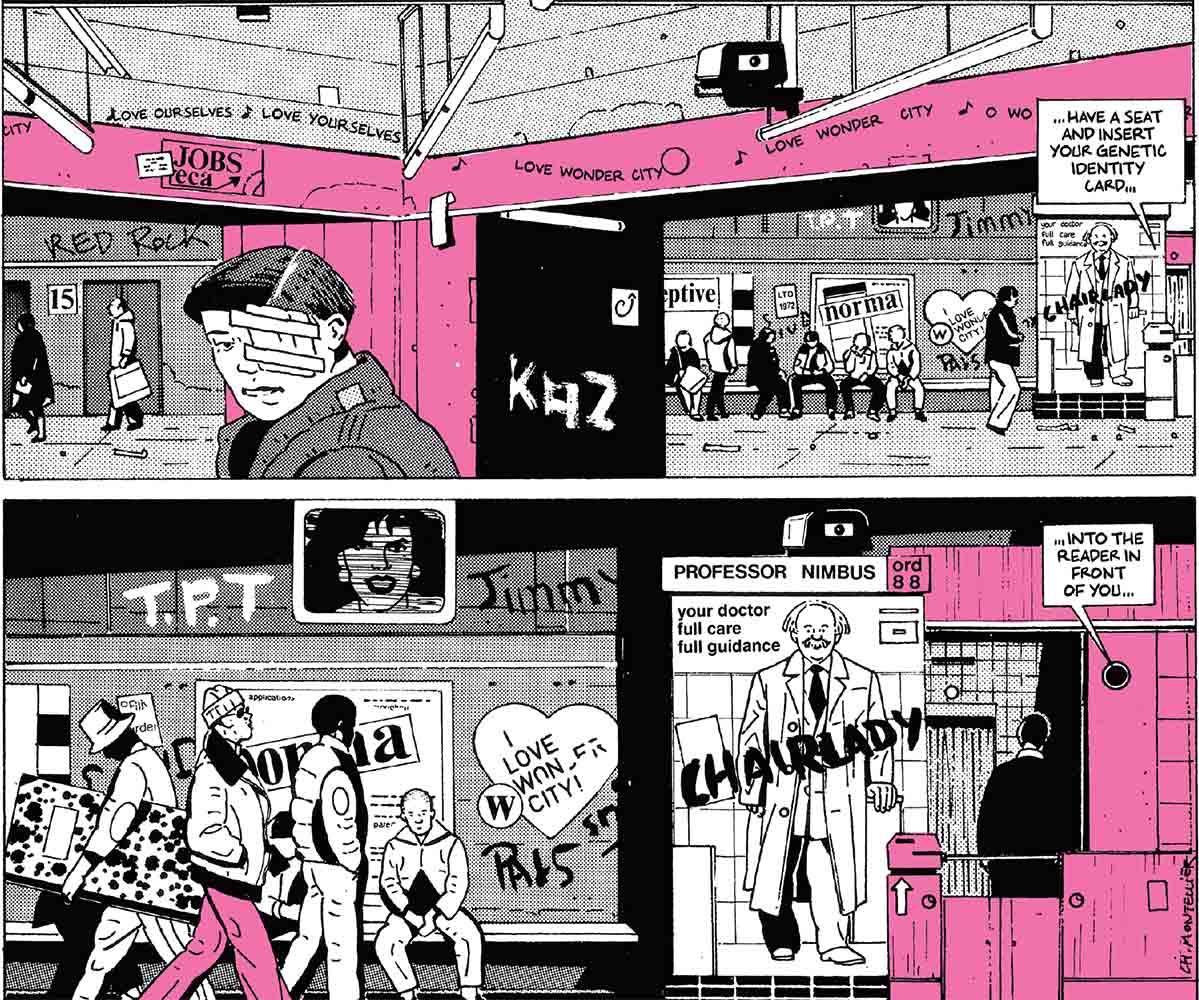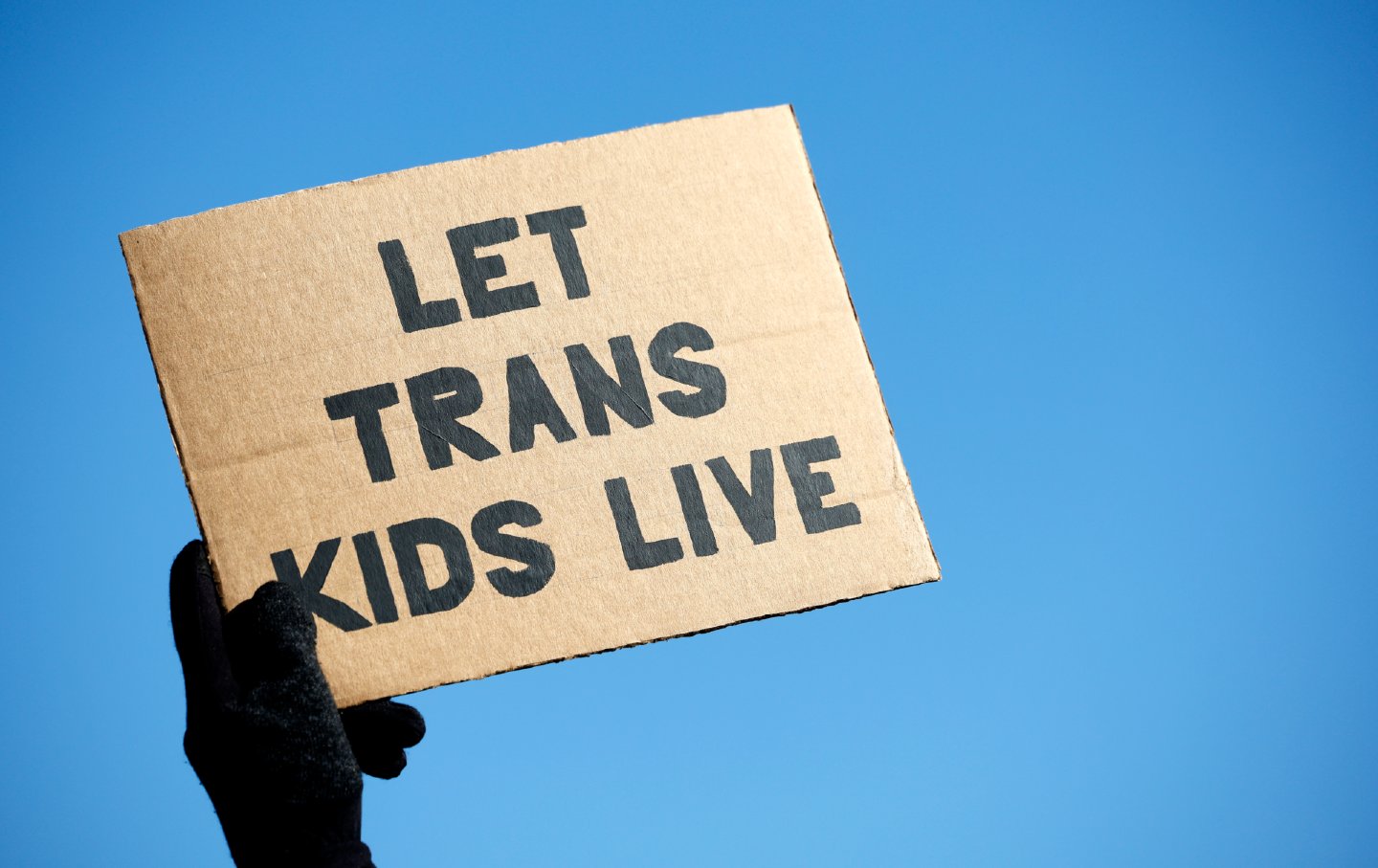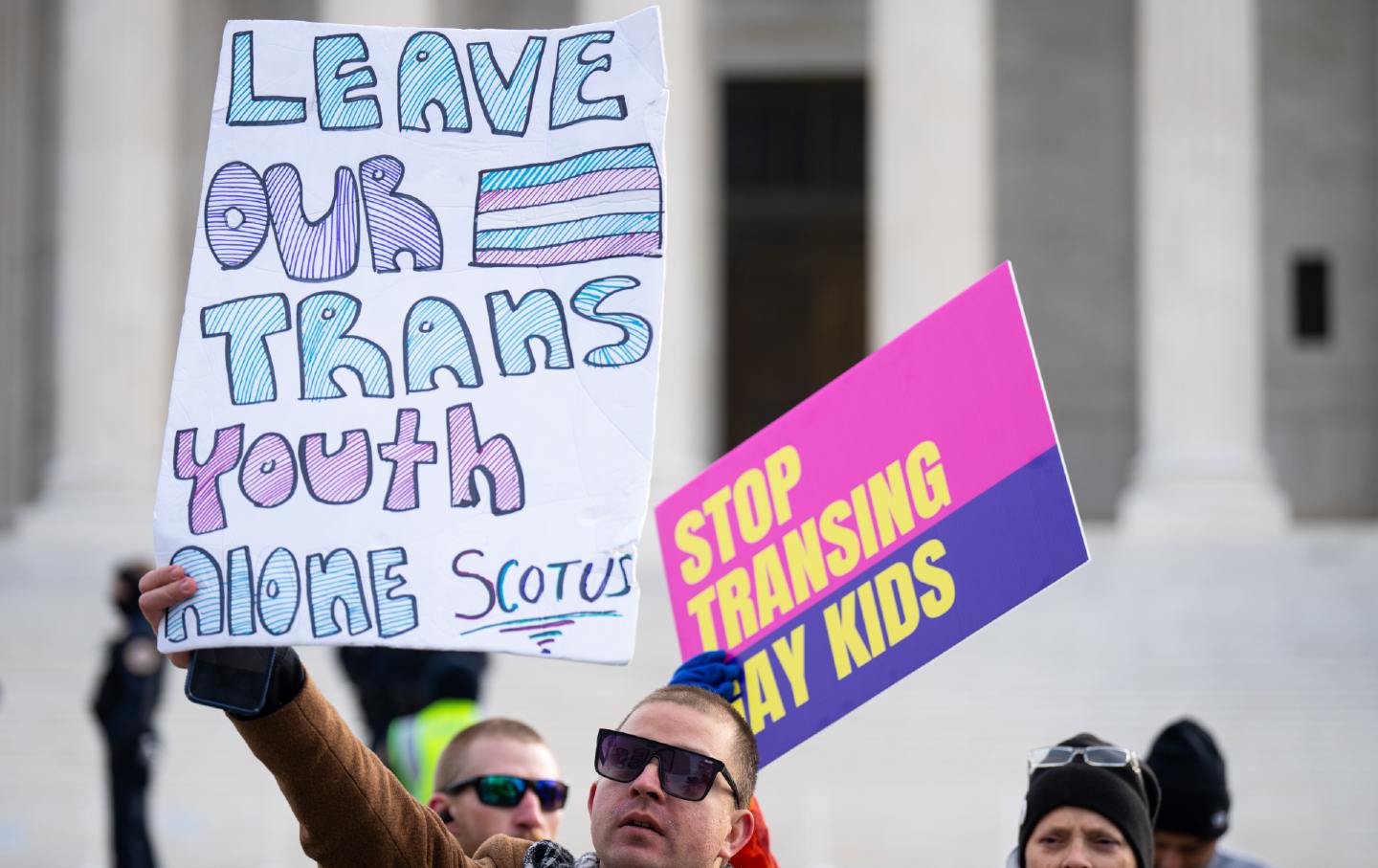In Wonder City
Chantal Montellier’s vision of the future.
Chantal Montellier’s Prescient Dystopias
A new volume collects the pioneering French comic artist’s work.

Why do we turn to dystopian fiction when disaster looms? Last year, after the Supreme Court overturned Roe v. Wade, protesters showed up to rallies dressed in the blood-red cloaks and white bonnets that Margaret Atwood conceived in her novel The Handmaid’s Tale. When we hear about robot dogs designed to patrol the southern border or generative AI systems giving podcast interviews, we think of Black Mirror’s “Metalhead” episode or Kazuo Ishiguro’s Klara and the Sun. And it’s nearly impossible to go a week in politics without someone bringing up George Orwell’s 1984 or Ray Bradbury’s Fahrenheit 451. In fictional dystopias, we look for language to express real fears, we find unexpected twists and complications, we echo alarm about the future.
Books in review
Social Fiction
Buy this bookBut novelists aren’t prophets, and the future often turns out to be both more complicated and more banal than we imagine. Instead of firefighters burning books, we have groups like Moms for Liberty taking over school boards and removing novels from library shelves. Instead of the Party watching us through telescreens, we willingly use devices and download apps that follow our movements and capture every word we say.
Dystopian fiction often has less to tell us about the future than it does about the era in which it is written. When The Handmaid’s Tale was published in 1985, for example, conservative activists had already persuaded five state legislatures to revoke their ratification of the Equal Rights Amendment; Jerry Falwell’s Moral Majority was pushing a national “family values” platform that opposed abortion, feminism, and gay rights; and Ronald Reagan was serving his second term as president. In building the Republic of Gilead, Atwood offered her readers a warning wrapped inside a thought experiment.
The future that the French artist Chantal Montellier imagined in the 1970s and ’80s, when her dystopian comics ran in the magazine Métal Hurlant, is likewise ominous. Montellier envisioned a society in which the government requires loyalty oaths, culture is drenched in vulgarity, and women have lost their reproductive rights to gestational innovations. In this work, she explores French anxieties about the end of the trentes glorieuses (a period of unprecedented economic prosperity that lasted from 1945 to 1975), the rise of decadent consumerism, modern technology, and a new world order. Yet even in her bleak visions of the future, Montellier’s focus remains on her characters’ struggle for dignity and liberation.
Montellier is an unusual figure in French comics. Less famous than Claire Bretécher, who satirized bourgeois life in her widely popular Agrippine comic strip, and Marjane Satrapi, whose memoir Persepolis was adapted into a César-winning movie, Montellier is a politically engaged artist and a pioneer of the feminist movement in French comics. Born in 1947 near Saint-Étienne, she trained at the prestigious École des Beaux-Arts but found the school stuffy and the students apathetic. After completing her degree, she began teaching visual arts at a high school in Haute-Savoie, a job that left her little time to pursue her passion—painting. She fell into comics in 1972, almost by chance, when a friend offered her a job as an editorial cartoonist for Combat syndicaliste, an anarcho-syndicalist newspaper that covered the concerns and interests of French workers.
Over the next 50 years, Montellier produced an impressive and wide-ranging body of work: political cartoons, comic books, art portfolios, essays, novels, and collections of stories. She developed a reputation as a rebel, unafraid to call out misogyny and fearless in her commitment to her ideals. Although some of her dystopian comic strips were released in the United States in the 1980s in the sci-fi magazine Heavy Metal, she remains largely unknown here. But US audiences may finally get to know her work this year, as three of her bandes dessinées, translated by Geoffrey Brock and collected under the title Social Fiction, have just been published by New York Review Books.
In France, bandes dessinées are part of a tradition that dates back at least a century, to newspaper strips like Les Pieds Nickelés, which relied on text beneath black-and-white drawings of three slackers, or Zig et Puce, which used speech balloons to convey the dialogue of its teenage heroes. Belgian artists like Hergé, Morris, and Peyo broadened the appeal of comics through their use of the adventure genre in Tintin, the western in Lucky Luke, and fantasy in The Smurfs. By 1959, when René Goscinny and Albert Uderzo debuted Astérix, about a village of indomitable Gauls fighting Roman invaders, comic book sales had skyrocketed. To date, Astérix has sold 385 million copies worldwide.
Bandes dessinées aren’t just a popular export. A recent poll found that 75 percent of French people consider Astérix and Tintin to be a part of their cultural heritage as prestigious as literary classics like Les Misérables or The Count of Monte Cristo. French comics are published in handsome hardcover editions that make collecting a pleasure as much as a compulsion. They’re reviewed in literary magazines and celebrated in venues around the country, including the prestigious Angoulême International Comics Festival, a four-day event that draws hundreds of thousands of attendees.
Yet tradition can easily mask inequity. In 2016, Angoulême was plunged into controversy after festival organizers published their annual prize shortlist of 30 artists, none of them women. The oversight illustrated a long-standing sexism within the industry, with women cartoonists receiving less attention for their art and fewer professional opportunities. There was also the stereotypical characterization and objectification of girls and women in the work of male cartoonists.
Chantal Montellier was not one to await recognition via a prize at the Angoulême Festival. Her pioneering work in comics appears to have taught her that it’s a fool’s errand for marginalized artists to expect recognition from establishment systems; instead, they have to find ways to nurture their work themselves. A decade before the brouhaha at Angoulême, Montellier and another pathbreaking comics illustrator, Jeanne Puchol, established the Artémisia Prize (named for the Italian Baroque painter Artemisia Gentileschi), which recognizes outstanding work by women cartoonists in multiple categories, including memoir, humor, and fiction. Since its founding, the prize has brought attention to artists like Laureline Mattiussi, Ulli Lust, and Sandrine Revel.
Montellier’s commitment to feminism has been unflagging, no doubt owing to the sexism she encountered as a trailblazer in French comics. In an interview with the social scientists Marianne Cailloux, Françoise F. Laot, and Anne Monjaret, she described the blunt refusal of her editors at L’Humanité dimanche to run a cartoon she drew in 1975, after abortion became legal in France, in which she criticized hospitals that allowed doctors to opt out of performing the procedure. “It was as if I was breaking a taboo without meaning to,” Montellier recalled. The problem, she felt, wasn’t so much that she was a woman cartoonist in a male newsroom, but that she had made feminine concerns visible.
Not long after this incident, Montellier went to work for Ah! Nana, a graphic magazine drawn entirely by women. It lasted only nine issues, because the editors were accused of publishing “pornography” after they ran comics that explored the female body, child prostitution, domestic violence, homosexuality, and other subjects considered taboo. The fact that actual porn was being sold freely in kiosks only seemed to prove the point that women were to be seen and drawn solely for the pleasure of male readers. But like her peers at Ah! Nana, Montellier wanted to show women through the gaze of one of their own, a feminist sensibility that is evident throughout Social Fiction.
Popular
“swipe left below to view more authors”Swipe →Social Fiction features three self-contained graphic novellas. The first, Wonder City, begins with a splash page that shows a massive street poster, on which a glamorous couple is locked in an embrace, beneath repeated commands to “Love yourselves, love Wonder City.” In the background are the skyscrapers of a metropolis, while in the foreground, an armed policeman has raised his truncheon to strike unseen protesters. The symmetrical lines and juxtapositions of this visual quickly establish the themes that Montellier will set against each other in her story: state control and human rights.
An epidemic has just broken out in Wonder City, a state of emergency has been declared, and communications have been cut. These new restrictions come on the heels of mass censorship and the suspension of civil liberties. The only solace that city resident Freddy Foster has is live music, and it is while attending a jazz performance one night that he meets and falls in love with Angie Parker, a militant and musician. When the couple seek permission to have a child, they are denied it on the grounds that Angie’s tests show she is infertile. But is this denial based on her test results, or is Angie being punished for her activism?
Although Wonder City begins with Freddy at work in his lab at the Institute of Demographic Control, it is Angie who drives the narrative. She’s highly critical of the government, gets arrested after talking back to a cop, and encourages Freddy to use his security clearance to snoop through her genetics file and find out why she’s been denied permission to have a baby. Freddy uncovers a government conspiracy to manage the city’s gene pool by allowing only a select few to have children and sterilizing everyone else. Later, standing under a one-way sign, he realizes that those affected “belong to the so-called lower classes. Almost all are from nonwhite backgrounds.”
Control of women and minorities looms large in this bande dessinée, with Montellier continually highlighting the connection between white supremacy and restrictions on reproductive rights. She draws the female body from Angie’s perspective, both in terms of her pleasurable experiences of sex and her nightmares about eugenicist experimentation. As the story unfolds, we come to see Angie in the role of outsider, dissident, and eventually rebel.
Shelter, the second comic in Social Fiction, originally appeared in Métal Hurlant in 1978. In it, a bourgeois couple, Theresa and Jean, stop by a subterranean mall on their way to a dinner party and find themselves marooned inside it during a nuclear attack. “You have nothing to fear,” the mall director reassures the shoppers. “This shelter is designed to function perfectly autonomously and can support 15,000 occupants for one year.” Armed security officers shepherd the stunned patrons to the auditorium, where they receive orders to sign up for jobs that will ensure the survival of the community. (The premise will seem familiar to readers of Hugh Howey’s Silo books, recently adapted into a series on AppleTV.)
The mall authorities provide everyone with not just food and shelter but also clothing, books, and movies—all for free. “To each according to his needs, in a way,” Theresa quips. She has been assigned the position of librarian, but in short order she notices that security officers show up with lists of books they borrow, only to never return. “Bookburning without fire,” she remarks to Jean.
Cold War worries permeate the narrative, with the survivors having to balance their fear of the unknown against their desire for safety. Theresa’s continual criticisms attract the attention of two acolytes of the security forces, who assault her in a brutal scene rendered in four panels on a single page. The only word spoken is Theresa’s “No,” set in large, bold type and repeated across the panels. As in Wonder City, the violence that is visited on the female protagonist crystallizes her anger and drives her to liberatory action.
The third section of Social Fiction is taken up by 1996, a series of comics set mostly in a future United States where people are subjected to lab experiments, women are shot for sport, and, even in death, white corpses are treated with greater dignity than nonwhite ones. Montellier told the comics journalist Paul Gravett that 1996 was inspired by the “visual shock” she felt after watching American movies like THX 1138 and Blade Runner, which gave her the impression of “something irredeemably ferocious, cruel, crass, violent and perverted.” A visit to New York in the 1980s apparently did nothing to change this view.
Authoritarianism and resistance to it are twin threads that run through the dystopias of Social Fiction. In Montellier’s vision of the future, control seems to reside almost exclusively with the political elite, and what violence is committed is executed by the government and its sympathizers rather than driven by personal grievances. Women’s bodily autonomy is another recurring theme, with contraception, pregnancy, and abortion serving as points of tension throughout the comics in this collection.
Montellier’s drawings favor clean, symmetrical lines and a meticulous attention to detail. In the pre-Internet days, she had to take photographs of sites of interest and draw them by hand to achieve her signature nouveau realist style. (The mall in Shelter, for example, is based on Belle Épine, a massive commercial center outside Paris.) Here and there, she adds comic touches, such as the three cats that follow and comment on Angie’s adventures in Wonder City. The dialogue is beautifully and idiomatically rendered in English by the poet Geoffrey Brock, who also contributes an introductory note and an interview with the author.
Seen from the vantage point of the late ’70s and early ’80s, the future appears full of violence—much like our present. Yet in her bandes dessinées, Montellier also offers us hope for liberation. “You don’t seem too worried,” a colleague remarks to Freddy at the start of Wonder City. “That’s right. I’m not worried,” he replies. “There will always be people to fight against that kind of stuff.” Perhaps this is another appeal of dystopian fiction: It shows us that we are always living through the apocalypse, and that we will always look for ways to survive it.
More from The Nation

My Dystopian Novel Predicted Trump 2.0 My Dystopian Novel Predicted Trump 2.0
SOLIS was meant to serve as a warning of what could come. With Trump’s reelection, it should serve as a blueprint for the bravery and activism needed to fight back.

President Biden Should Issue a Blanket Pardon of Undocumented Immigrants President Biden Should Issue a Blanket Pardon of Undocumented Immigrants
Protecting Trump’s enemies from prosecution just reinforces the idea of politics as retribution. Instead, Democrats should be defending his most vulnerable targets.

The Supreme Court’s Hearing on Trans Rights Was Bigotry Masquerading as Law The Supreme Court’s Hearing on Trans Rights Was Bigotry Masquerading as Law
The conservative majority spent much of the oral arguments for US v. Skrmetti trying to erase the trans community.

Will There Be a Bird Flu Epidemic Under Trump? Will There Be a Bird Flu Epidemic Under Trump?
H5N1 currently poses a real threat for human transmission. Meanwhile, Trump’s picks for public health roles don’t bode well for vaccination.

Trans Medicine’s “Merchants of Doubt” Trans Medicine’s “Merchants of Doubt”
There is plenty of uncertainty involved in gender-affirming care—as in most aspects of medicine. But the groups behind the Tennessee ban aren’t driven by science—or patient care.

Donald Trump’s Second Administration Will Be As Women-Hating as Ever Donald Trump’s Second Administration Will Be As Women-Hating as Ever
"Your body, my choice" is only the beginning.


